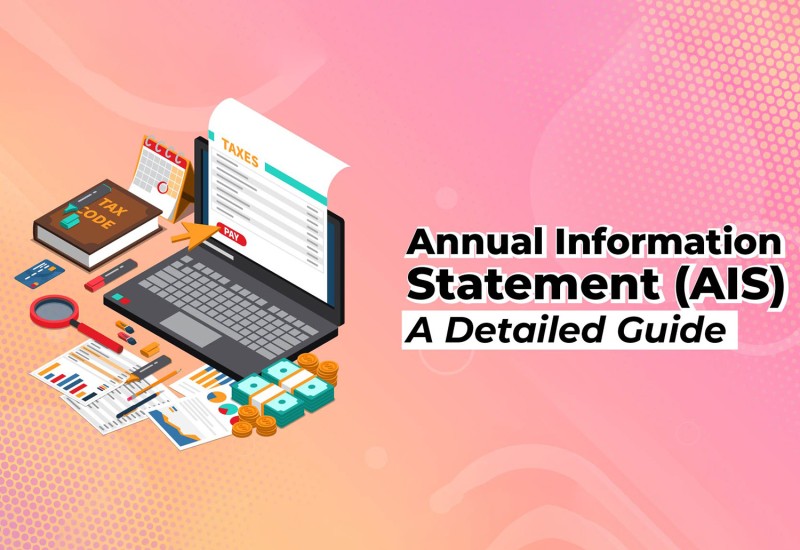
Know what is AIS and why it is important
The Annual Information Statement (AIS) is an important tool used by the tax department to inform taxpayers of their financial transactions for a given financial year.
It includes details such as interest, dividends, stock trades, mutual fund activities, and international remittance details. The AIS can be obtained in the formats of PDF, JSON, and CSV.
In this article, we will discuss the pain points associated with using an accounting information system to file taxes and the importance of filing the AIS correctly.
What is the Annual Information Statement (AIS)?
The Annual Information Statement (AIS) is a comprehensive view of information for a taxpayer as reflected in Form 26AS.
It displays a range of information which includes details of Tax Deducted at Source (TDS), Tax Collected at Source (TCS) and other payments like self-assessment tax, advance tax, etc.
The AIS also shows the details of interest credited by the banks and the amount of tax refund claimed or adjusted towards outstanding taxes.
Taxpayers have the option to provide feedback on the information displayed in AIS through their online accounts. This feedback is taken into consideration before calculating the modified value. The modified value is the value after considering the taxpayer’s feedback.
The objectives of AIS are:
- Display complete information to the taxpayer with a facility to capture online feedback.
- Promote voluntary compliance and enable seamless prefilling of returns.
- Deter non-compliance.
By viewing all the transactions reported under each section (i.e. TDS, SFT, Other information) in the AIS, taxpayers can get an accurate idea of their financial position and ensure accuracy in filing their taxes.
Difference between AIS and Form 26AS
|
Parameter |
Form 26AS |
Annual Information Statement (AIS) |
|
Purpose |
Tax credit statement to reconcile TDS/TCS transactions |
A comprehensive statement providing financial information related to taxpayers, including TDS/TCS transactions and additional financial activities |
|
Contents
|
- Property purchases - High-value investments - TDS/TCS transactions - Advance tax payments and refunds (if any) |
- Savings account interest - Purchase and sale transactions of securities/immovable properties - Foreign remittances - Interest on deposits - TDS/TCS transactions - SFT information - Payment of taxes, demand or refund |
|
Deposit Interest Details |
Displays only TDS-deducted deposit interest details |
Shows both transaction details and bank account details from where the income was received |
|
GST Details |
Captures GST details |
Does not capture GST details |
|
Level of Detail |
Provides basic information related to TDS/TCS and some financial activities |
Offers a more detailed overview of an individual's financial activities, including both TDS/TCS transactions and various other financial transactions |
|
Use in Tax Filing |
Used by taxpayers to verify and reconcile tax deducted at source (TDS) |
Taxpayers can use it to cross-verify financial information and ensure accurate reporting of income and expenses during tax filing, although not mandatory for tax filing purposes |
Why do not file ITR without AIS?
The Income Tax Department is pushing people to file their Income Tax Returns (ITR) ahead of FY23. Since more people are submitting ITRs, the number of filers has increased rapidly.
The Income Tax Department has also tried to make the ITR filing process easier.
Even though it is now easy to file an ITR, people shouldn't forget to file the Annual Information Statement (AIS) along with their ITR.
What is in the AIS Form?
The Annual Information Statement (AIS) form is a mandatory form that must be submitted to the Income Tax Department by all taxpayers.
It contains detailed information on all income earned through different sources, such as savings account interest income, recurring and fixed deposit income, income from dividends, mutual funds and securities transactions, money received from abroad, and so on.
The AIS form was previously on a trial basis but is now compulsory for all taxpayers.
The salaried class usually files their income tax returns (ITR) based on Form 16. However, AIS and TIS (Tax Information Statement) forms are useful for other types of income, such as rent, capital gains, and gifts.
AIS provides detailed information about all income that is in the taxable category, and TIS is a summary of this information.
Documents Required Before Filing Return
The department recommends that you keep certain documents ready before filing the return. These documents include the following:
- Form 16
- Bank statement
- Interest certificate from the bank
- Statement of home loan if there is any deduction
- Statement of profit and loss of demat account
- 26AS and Annual Information Statement
- Details of any tax invoice filled
- Details of any donation given and details of income from other sources.
Having all these documents ready will help ensure a smooth and accurate filing process.
How can I view the Annual Information Statement?
The Annual Information Statement (AIS) can be accessed by logging in to the e-filing portal at https://www.incometax.gov.in/.
Once you are logged in, click on “Annual Information Statement (AIS)” under the “Services” tab from the e-filing portal.
On the homepage of AIS, click on the AIS tab and select the relevant Financial Year (FY) for which you need to view the AIS.
Then click on the AIS tile to view the Annual Information Statement.
For more details on AIS, kindly refer to Annual Information Statement User Guide available in the “Resources” section on AIS Homepage.
Wrapping Up
The Annual Information Statement (AIS) is an essential document that provides taxpayers with a complete view of their financial transactions for a given financial year. Filing the AIS correctly is crucial to ensure the accuracy of tax returns and avoid penalties for non-compliance.
Taxpayers should also ensure they have all the necessary documents ready before filing their returns and can access their AIS through the e-filing portal. By using AIS and other tax forms correctly, taxpayers can promote voluntary compliance and make the tax-filing process more seamless.